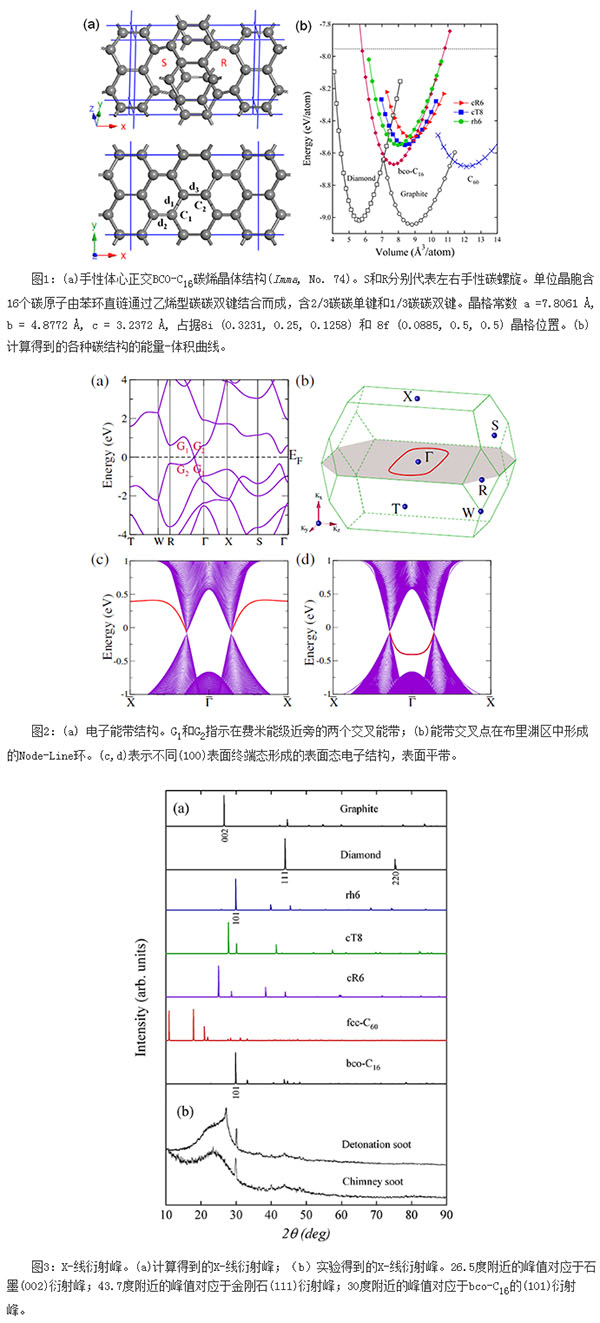Carbon is one of the most widely distributed and existing elements in nature. Four basic carbon-carbon bond configurations can be obtained from simple hydrocarbons: ethane (H3C-CH3) carbon-carbon single bond, ethylene (H2C=CH2) carbon-carbon double bond, acetylene (HC≡CH) carbon-carbon triple bond And phenyl large π bond structure. The large π bond of phenyl group forms a stable two-dimensional graphene, and the single carbon-carbon bond of the alkyl group constitutes a three-dimensional diamond, and the alkynyl carbon-carbon triple bond forms a carbon atom chain. In recent years, the discovery and synthesis of zero-dimensional C60 fullerene spheres, one-dimensional carbon nanotubes, and two-dimensional graphene have stimulated people's interest in exploring new carbon crystal structures. However, the research on the crystal structure of three-dimensional all-sp2 carbene (or three-dimensional version of graphene) has not been satisfactory for a long time. Since 2012, scientists have focused on the design of three-dimensional carbene crystal structures by folding and reconstituting one-dimensional carbon chains. Based on the ethylene-carbon double bond, researchers have proposed a three-dimensional carbene crystal structure model reconstructed from three-fold, four-fold and six-fold helical carbon atom chains [Sci. Rep. 3, 03077 (2013); Sci. Rep. 4, 04339 (2014)], found that three-fold cR6 and four-fold cT8 three-dimensional crystal structures consist of reverse chiral carbon chains, and six-fold Rh6 three-dimensional carbene crystal structures consist of monochiral carbon chains, respectively. With R-3m, I41/amd and R-3m symmetry. The band calculations show that these chiral carbene crystal structures exhibit semiconducting properties with band gaps of 2.95 eV, 2.41 eV, and 0.47 eV, respectively. Recent experiments have shown that Rh6 and its dense phase Rh6-II carbon crystal structure can be synthesized by grinding amorphous carbon ash containing fullerene balls [Carbon 102, 288 (2016)]. Based on the above work, recently, the Institute of Physics, Chinese Academy of Sciences/Beijing National Laboratory for Condensed Matter Physics (CPC) Wang Jiantao, Associate Researcher Weng Hongming, Ph.D. Student Nie Simin, Researcher Fang Zhong, Professor at Tohoku University of Japan, Chuan Tianliang, and Professor of Nevada University, Chen Changfeng Collaboration, through first-principles calculations, proposed a new three-dimensional carbene crystal structure composed of six-fold reversed chiral carbon atoms (Figure 1a). The structure has a body-center orthogonal symmetry, and the unit cell contains 16 carbon atoms, so it is abbreviated as BCO-C16 carbon. At the same time, its reverse chiral carbon atom chain is formed through the ethylenic carbon-carbon double bond to form a benzene ring. Therefore, BCO-C16 carbon can also be regarded as a benzene ring through the ethylene-carbon double bond. "Three-dimensional version of graphene" or "three-dimensional graphene." Its structural characteristics are similar to those of cR6, cT8, and Rh6 carbon, and contain 2/3 carbon-carbon single bonds and 1/3 carbon-carbon double bonds. However, because of its unique conjugated reverse chiral structure, BCO-C16 is more stable than Rh6 on energy, roughly equal to that of solid C60 (Fig. 1b). Detailed band calculations show that this new three-dimensional graphene carbon structure exhibits Node-Line semi-metallic properties (see Figure 2). In the two-dimensional graphene, the energy band near the Fermi level forms a cross point (Dirac point), but in the three-dimensional BCO-C16 crystal, the band intersection (Fig. 2a) forms a continuous closed curve in the momentum space (red Ring, Figure 2b). And when this curve is projected onto the (100) surface of the material, the tympanic-like two-dimensional surface flat band with very little energy dispersion in the receptor state topology (red curves, Figs. 2c, 2d) appears. Through detailed comparison analysis of experimental data reported by X-ray diffraction and previous reports, it was found that the three-dimensional graphene crystal structure composed of a benzene ring or a benzene ring may exist in the combustion or explosion-produced char, at about 30 degrees. There is a significant diffraction peak (Figure 3). The discovery of the three-dimensional chiral graphene crystal structure has formed a complete carbene structure series from zero-dimensional fullerene spheres, one-dimensional carbon nanotubes, two-dimensional graphene, and three-dimensional carbene. These results have important scientific significance for a comprehensive understanding of carbon crystal configuration and related physical properties, and will stimulate the development of relevant experimental work. The results of the relevant study were published in Phys. Rev. Lett. 116, published on May 11, 195501 (2016). This work was supported by the National Natural Science Foundation of China (Grant No. 11274356, 11274359, 11422428), the Chinese Academy of Sciences Pilot Project B and the Ministry of Science and Technology "973" project. Thermostatic Shower Set,Thermostatic Shower,Head Shower Set,Shower Mixer Taps kaiping aida sanitary ware technology co.,ltd , https://www.aidafaucets.com